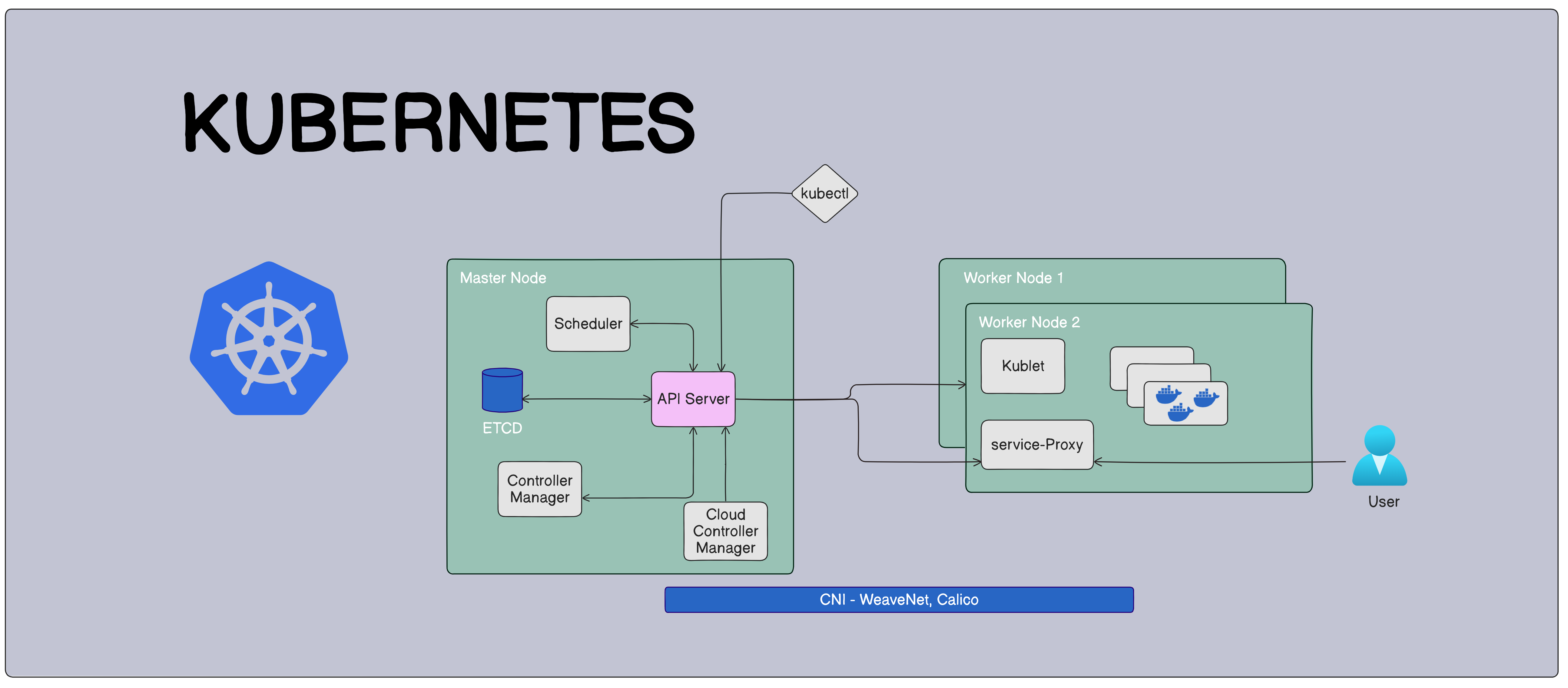Understanding Kubernetes Architecture
 Prashant Bale
Prashant Bale
Kubernetes, an open source platform designed to automate deploying, scaling and operating application containers, has a robust architecture that ensures high availability and scalability.
In this post, we will dive into the key components of Kubernetes architecture as illustrated in the diagram.
Master Node Components
The Master Node is the Control Plane responsible for managing the Kubernetes cluster. It consist of several key components:
API Server:
ETCD
Scheduler
Controller Manager
Cloud Controller Manager
API Server
Role: Acts as a front end for the Kubernetes Control Plane.
Functionality: Handles RESTful operations, providing an interface for all cluster operations. It validates and configures data for the API Objects, including Pods, services and Deployments.
Communication: All components (both internal and external) interact with the API Server using API calls. It also performs authentication and authorization checks, handling resource admission control.
ETCD
Role: Serves as a Persistent Data Store for Kubernetes
Functionality: Stores the entire configuration and state of the cluster. As a distributed key-value store, it ensures high availability and consistency of the data.
Communication: Other components, like the API Server, access ETCD to retreive or store configuration details and cluster states.
Scheduler
Role: Assign nodes to newly created pods.
Functionality: Watches for unassigned pods and finds the best fit for them based on resource requirements, policies, and constraints like affinity/anti-affinity rules.
Communication: Communicates with the API Server to retrieve unassigned pods and update their status once assigned.
Controller Manager:
Role: Manages various controllers that regulated the cluster.
Functionality: Runs different controllers like the Node Controller (monitors node health), Replication Controller (maintains the correct number of pod replicas), and others that handle endpoint, namespace, and service accounts.
Communication: Interacts with the API Server to ensure the actual state of the cluster matches the desired state defined by the user.
Cloud Controller Manager
Role: Integrates with the cloud provider's API
Functionality: Manages cloud-specific control loops, including node lifecycle, routing, and persistent storage provisioning.
Communication: Communicates with cloud provider APIs and the API Server to manage cloud-specific resources.
Worker Node Components
Worker Nodes are the machines that run the applications managed by Kubernetes. Each Node has several essential components:
Kubelet
Role: Ensures containers are running as expected on each node.
Functionality: Monitors pod specifications and ensures the containers described in these specs are running and healthy. It interacts with the container runtime to start, stop, and manage containers.
Communication: Communicates with the API Server to receive pod specs and report the status of pods to the control plane.
Kube-Proxy or Service-Proxy
Role: Maintains network rules on each node.
Functionality: Handles network communication both inside and outside of the Kubernetes cluster by implementing load balancing and network address translation (NAT) for services.
Communication: Communicates with the API Server to receive service specifications and update network rules accordingly.
Container Runtime
Role: Manages the lifecycle of containers.
Functionality: Supports running containers in a pod. Common container runtimes include Docker, containerd, and CRI-O.
Communication: Interacts with the Kubelet to run and manage the containers based on the pod specs.
Other Important Components
Kubectl
Role: Command line tool for interacting with the Kubernetes Cluster.
Functionality: Allow administrators and users to deploy applications, manage cluster resources, and view logs and cluster states.
Communication: Send commands and queries to the API Server, which processes these requests and communicates with other components needed.
CNI (Container Network Interface)
Role: Manages the network layer for containers.
Functionality: Ensures that networking is correctly configured so that pods can communicate with each other and with services outside the cluster. Popular CNI plugins include WeaveNet and Calico.
Communication: Interfaces with the kubelet and kube-proxy to configure networking for pods.
Conclusion
Kubernetes has revolutionized the way we deploy, manage, and scale containerized applications. Its powerful orchestration capabilities, combined with an ever-growing ecosystem of tools and extensions, make it an indispensable asset for modern software development and operations teams.
By mastering Kubernetes, you can achieve greater efficiency, resilience, and agility in your application deployments. Whether you are just starting out or looking to deepen your understanding, continuous learning and experimentation are key. Remember to keep up with the latest updates and best practices to fully harness the potential of Kubernetes in your infrastructure.
Thank you for following along on this journey through Kubernetes. If you have any questions, insights, or experiences to share, feel free to leave a comment below.
Happy containerizing !!!
Subscribe to my newsletter
Read articles from Prashant Bale directly inside your inbox. Subscribe to the newsletter, and don't miss out.
Written by

Prashant Bale
Prashant Bale
With 17+ years in software development and 14+ years specializing in Android app architecture and development, I am a seasoned Lead Android Developer. My comprehensive knowledge spans all phases of mobile application development, particularly within the banking domain. I excel at transforming business needs into secure, user-friendly solutions known for their scalability and durability. As a proven leader and Mobile Architect.